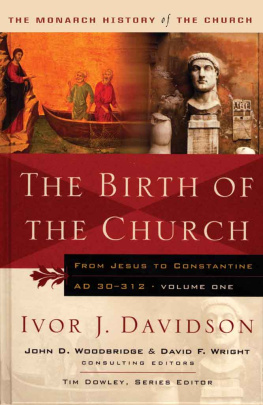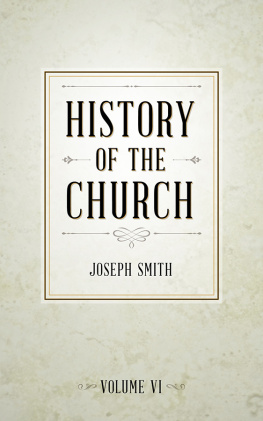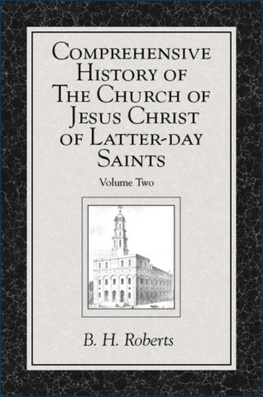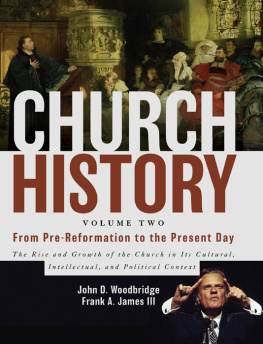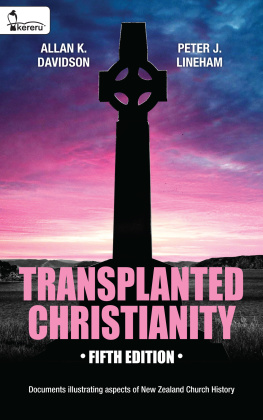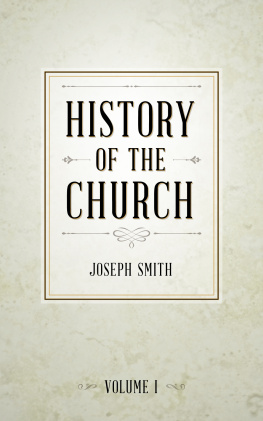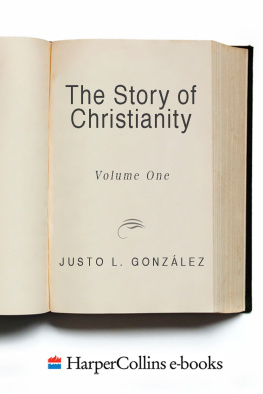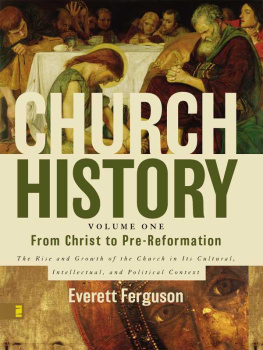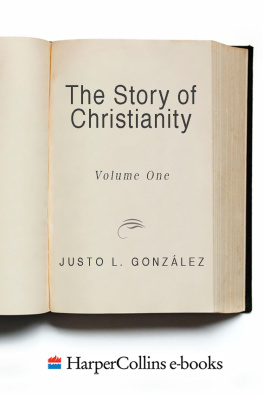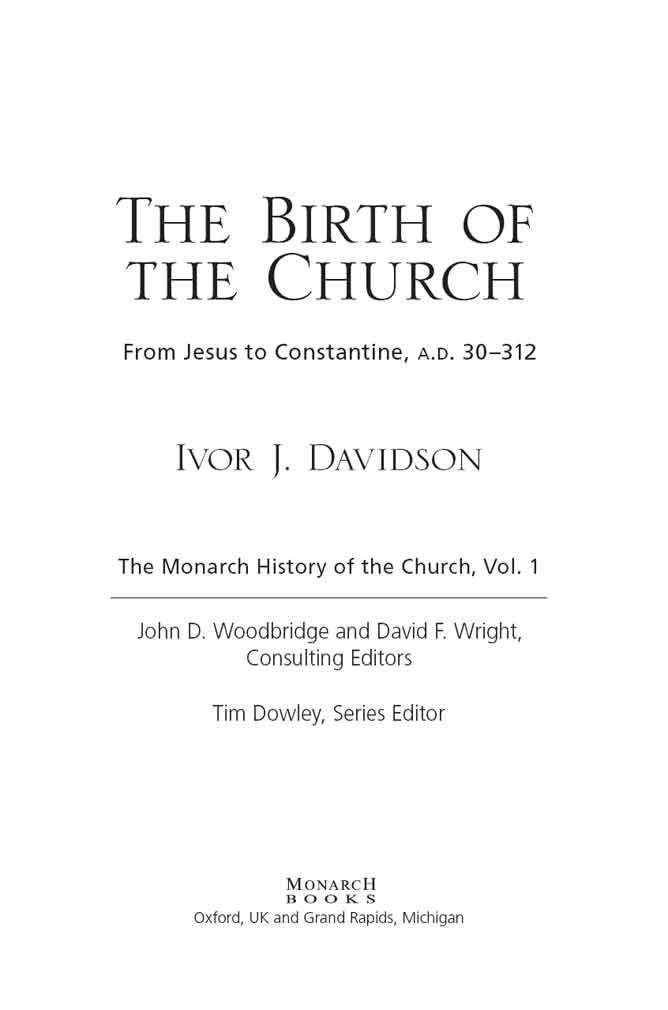
Copyright 2005 by Ivor J. Davidson
This edition copyright 2005 Lion Hudson
The right of Ivor J. Davidson to be identified as author of this work has been asserted by him in accordance with the Copyright, Designs and Patents Act 1988.
All rights reserved.
No part of this publication may be reproduced or transmitted in any form or by any means, electronic or mechanical, including photocopy, recording or any information storage and retrieval system, without permission in writing from the publisher.
Published by Monarch Books
an imprint of
Lion Hudson plc
Wilkinson House, Jordan Hill Road, Oxford OX2 8DR, England
Tel: +44 (0) 1865 302750 Fax: +44 (0) 1865 302757
Email: monarch@lionhudson.com
www.lionhudson.com/monarch
ISBN: 9781-85424-658-5
e-ISBN: 978-0-85721-384-6
First edition 2005
Unless otherwise stated, Scripture quotations are taken from the Holy Bible, New International Version, 1973, 1978, 1984 by the International Bible Society. Used by permission of Hodder and Stoughton Ltd. All rights reserved. All remaining quotations are taken from the English Standard Version of the Bible, published by HarperCollins Publishers, 2001 by Crossway Books, a division of Good News Publishers.
Used by permission. All rights reserved.
British Library Cataloguing Data
A catalogue record for this book is available from the British Library.
Cover image: Corbis
Setting and design reproduced from the 2004 Baker edition by agreement.
M APS AND I LLUSTRATIONS
Maps
Illustrations
P REFACE
Any number of guides exists for those who would learn about the early history of Christianity. This book was written in the conviction that there is nevertheless a need for a fresh narrative history of the early church that is accessible in style, comprehensive in scope, andnot leastup-to-date in scholarship.
It is of course a great deal easier to describe such aims than it is to realize them. Accessibility is always a matter of taste, and the quest for it involves authors and editors constructing illusory images of average readers who never quite match up to the actual individuals to whom they generally speak. Comprehensiveness is determined by the contingencies of word limits, time, energy, and knowledge. And the extent to which a work such as this can ever be up-to-date with all of the relevant literature is entirely relative: no scholar can be an expert in all of the component parts of such a vast and multidisciplinary field.
These have, nevertheless, been the ideals that I have tried to keep in mind as I have written. I hope the book will be of use to those who have some knowledge of early Christianity as well as to those who have noneit is designed, naturally, for students in universities, seminaries, and schools, but also for their teachers, and for all intelligent readers, Christian and otherwise, who wish to find out more about how the church began. While the content aspires to offer an appropriate level of substance and to incorporate the best of contemporary thinking in the field, I have sought to keep footnotes and references to a minimum in order to leave the text as unencumbered as possible by technical matters. I have tried to concentrate not only on issues of theology, politics, and ideas but also to look in some measure at the social, artistic, and cultural evolution of Christianity. I have also been conscious of the need to tell the churchs story not merely as the doings of a few famous people but as a process in which all who professed faith in Jesus were involved. In every area of the work, the constraints of space have been very real, and judgments about what to include and what to leave out will always be contestable; but I trust that the overall picture is as wide-ranging in its detail as might reasonably be expected in a study of this length.
I have endeavored to produce an account that is balanced and fair to diverse interpretations of often-complex evidence. At the same time, no historian can or should shy away from offering opinions on contested issues. In many instances, the full reasons behind the judgments expressed here could not possibly be rehearsed in the space available, but interested readers can follow up the relevant themes by pursuing some of the further reading suggested at the end of the book. Bibliographies are notoriously ephemeral in their adequacy, but the list given here should provide a start at least. Internet-based sources in some of the areas in question are of mixed quality, and for that reason I have confined the suggestions to conventional printed media. There is undoubtedly a very large and growing body of useful material to be gleaned from the Web, but the wheat and the chaff are best sifted by those who have done some other reading first.
When I was first asked to write the book, I was advised that the aim was to furnish a new generation of readers with a work that might fulfill something of the function that earlierand in some cases now classicintroductory texts on the period had provided for their predecessors. That is no small order, and I had then and have now no illusions about the challenges of fulfilling it. If the work should prove even a small part as useful as some of those that have gone before it, I shall of course be very pleased.
As always, an author must register his debts. I am very grateful to Baker Books for their enthusiastic sponsorship of the series, and in particular to my editor, Chad Allen, and his colleagues for their excellent work in overseeing its production. I appreciate the fine job done by Lois Stck in producing an American version of the text, and the skills of Kathleen Strattan who indexed the book. I am also grateful to staff at Monarch Books in London, especially Tony Collins, for their vital input. Dr. Tim Dowley has been an exemplary series editor, whose passionate commitment to the project has never wavered and whose encouragement, patience, and carefulness throughout the writing of this first volume have been greatly appreciated. I am grateful to an anonymous reader of the manuscript for his helpful suggestions. Not for the first time, I also owe much to Professor David Wright of the University of Edinburgh for his interest and generosity.
The University of Otago furnished me with research grants that assisted with the illustration of the book. I should like to record my appreciation to Jill Davidson, Bill Mooney, and in particular my research assistants Robyn Dold and Jacqui Davis for their hard work in that area. I am also grateful to those who agreed to allow reproduction of photographs from their personal collections: Professor Everett Ferguson deserves special thanks for lending me his image of the amphitheater in Lyons.
I dedicate the book to my parents: to my father, who has shown a lively interest in the project throughout its gestation, and who will, I hope, find some reasons for the reward of that enthusiasm now; and to the memory of my mother, who was called to a far better place several years before the work was begun, but who would undoubtedly have taken pride in perusing and discussing it had she been spared. I miss her, and her passion for the story of which this book tells a tiny part, more than any formal dedication can possibly record.
With her customary blend of extraordinary patience, good humor, and commitment, my wife Julie put up with me while I wrote the work, and gave up far too much of her own time in its interests. As ever, even a large thank you is a hopelessly inadequate return; but I offer it anyway, in the knowledge that the heart has further language of its own.

